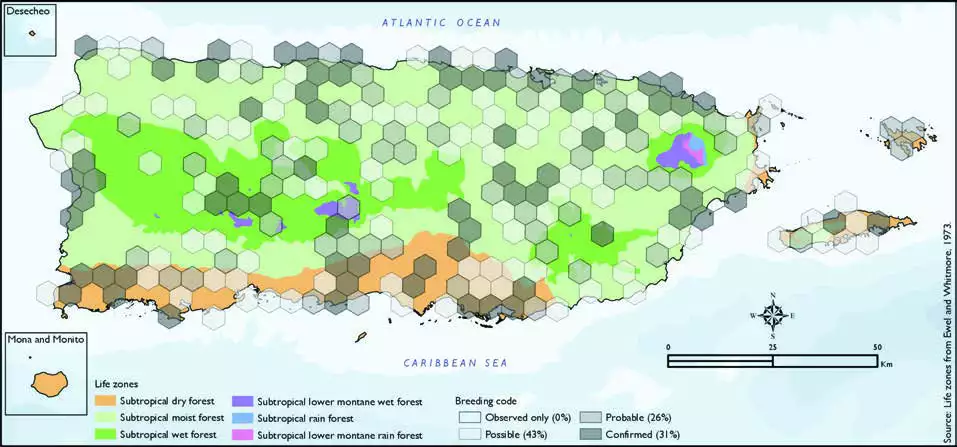Common Gallinule
Description
The common gallinule (Gallinula galeata) is a bird in the family Rallidae. It was split from the common moorhen by the American Ornithologists' Union in July 2011. It lives around well-vegetated marshes, ponds, canals, and other wetlands in the Americas. The species is not found in the polar regions or many tropical rainforests. Elsewhere, the common gallinule is likely the most commonly seen rail species in much of North America, except for the American coot in some regions.
Distribution & Habitat
The Common Gallinule is a common resident species in
Puerto Rico known to occur
in wetlands and various water
bodies throughout the main
island, Culebra, and Vieques
(Raffaele 1989a), in the latter
being a fairly common breeding
resident (Gemmill 2015). This
species is most common in
freshwater habitats among
rivers, brackish waters, canals,
ditches, mangroves, stream
banks, reservoirs, creeks, and
ponds with dense vegetation
(Oberle 2018). The atlas
fieldwork yielded a total of 449
records within 222 hexagons or 46 percent of the 479 total
hexagons (see map). Of the 222
hexagons where this species
was found, breeding met the
atlas definition of confirmed in
31 percent (69) of the hexagons,
probable in 26 percent (57), and
possible in 43 percent (95), while
the species was observed in an
additional hexagon (<1 percent)
but without evidence of breeding
(see map). Common Gallinule distribution. The map shows the highest breeding code by hexagon and overlaying the ecological life zones in
Puerto Rico. Note: percentages may not total 100 due to rounding.

Breeding Habits
The Common Gallinule builds its nest on fl oating vegetation, in a
shrub, or on the ground (Oberle
2018). Previously published
reports indicate that its breeding 97Common Gallinule/Gallareta Comúnactivity extends year-round, peaking in May to September
(Raffaele and others 1998). Atlas
results confirm that the breeding
season extends throughout the
year, but the highest breeding
activity peaks in March to June
(see chart). Results show that the
Common Gallinule is a habitat
generalist that breeds within all
ecological life zones except the
subtropical rain forest life zone,
a pattern that coincides with the
abundance of these life zones in the island. Most breeding
activity was reported within the
subtropical moist forest life zone
(65 percent of the hexagons),
followed by the subtropical dry
and subtropical wet forest life
zones (24 and 10 percent of the
hexagons, respectively) (see
table and map).
Conservation
The Common Gallinules overall population trend is suspected
to be stable, and it is listed as a species of least concern by
the IUCN (BirdLife International
2016). Locally, this species is not
listed in any of the threatened
categories of PRDNER and
USFWS. In Puerto Rico, the
Common Gallinule has a
protected habitat in land of 11
percent or 586 km2 of the total area covered by the hexagons
where evidence of breeding
was found for this species
(5283 km2).
Related Species
Family:
rail